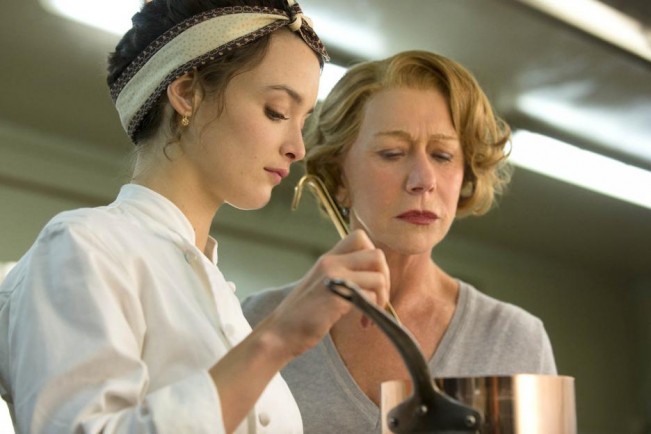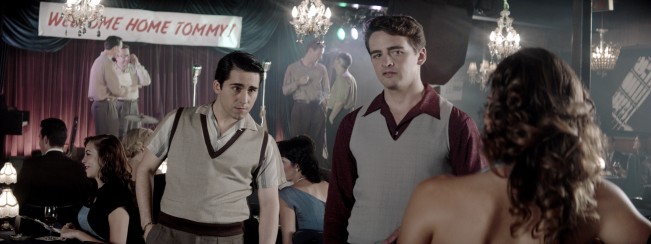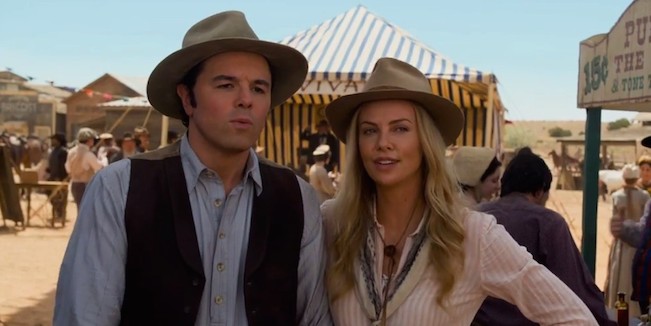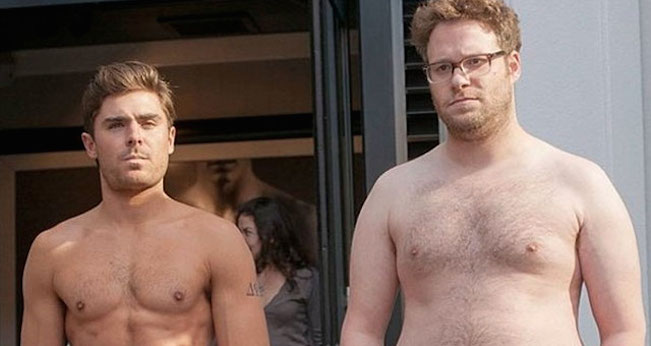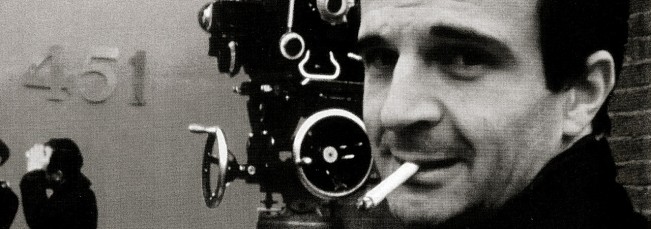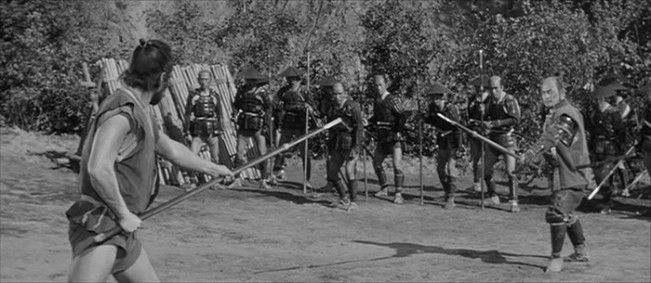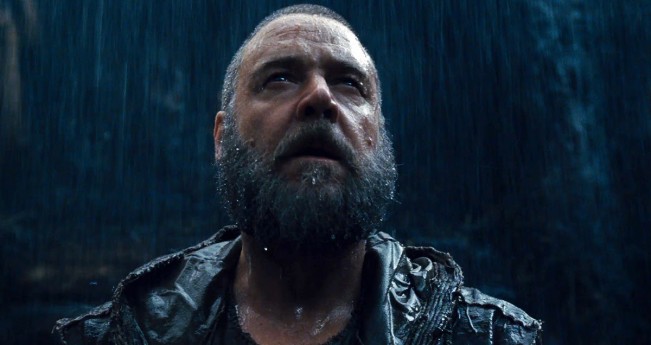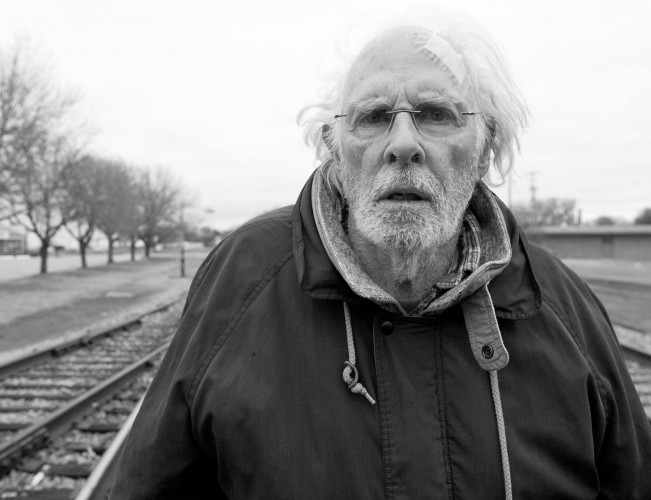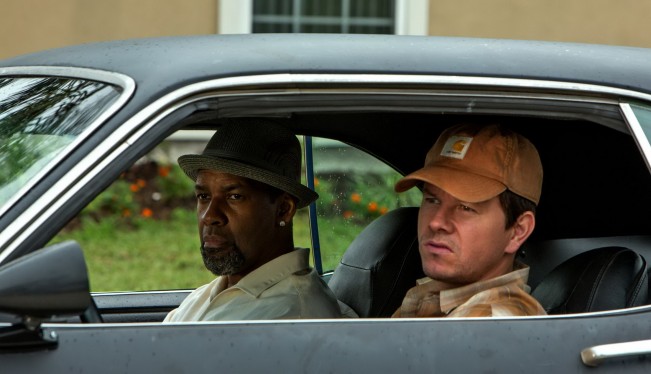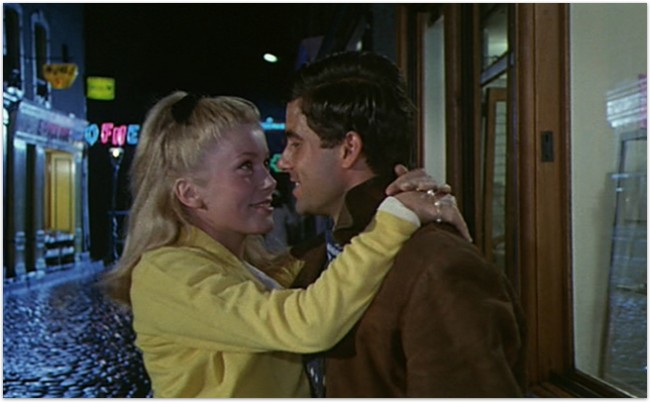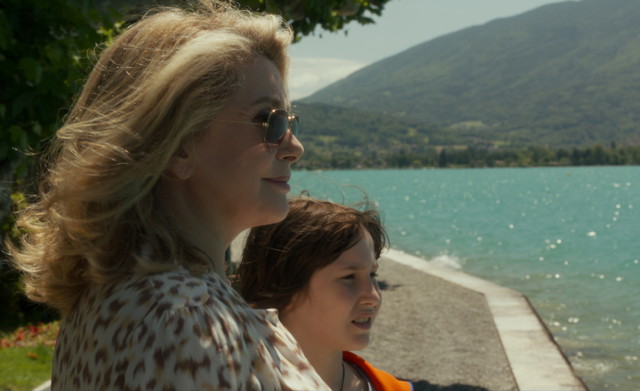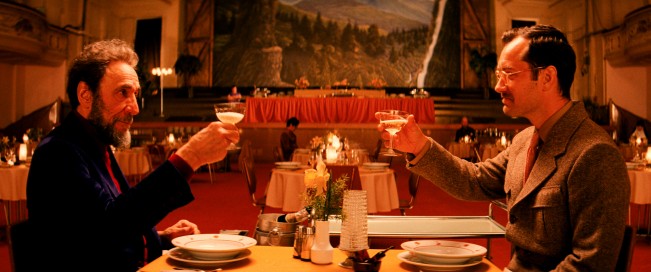THE TCM 2014 CLASSIC FILM FESTIVAL
I. I will hold your coat

Families, at their best, give us solace and they give us joy. At their worst, they tear us apart. Both extremes were visible on screen at this year’s TCM Classic Film Festival: often the best (How Green Was My Valley) and sometimes the worst (Whatever Happened to Baby Jane?), but always the crucial parts of a film to remember.
The 2014 TCM Festival — the fifth annual edition of one of the world’s great (and certainly one of its most lovable) film fests — was devoted this year to the theme: “Family in the Movies: The Ties That Bind.” And during its four day run, hosted by TCM’s affable and knowledgeable on-air movie guides Robert Osborne and Ben Mankiewicz, with many special guests and some first-rate venues (the TLC Chinese Theatres, Grauman‘s Egyptian Theatre, Disney’s flagship El Capitan, plus poolside outdoor movies at the Roosevelt Hotel), this bounteous cinematic fest became a celebration of fathers, mothers, daughters, sons and other blood ties. They presented over seventy movies and some real film masterpieces on the main subject.
We had a great time, though we only caught a fraction of the bill of fare.
Is there any more powerful or moving portrait, for example, of a loving family facing the vicissitudes of life and surviving the relentless march of change than director John Ford and screenwriter Phillip Dunne’s magnificent saga of the Morgan clan of turn-of-the-century Wales, as immortalized in Richard Llewellyn’s memoir-novel “How Green Was My Valley?” There it was, in the TCM fest’s gala showing at the Disney flagship theatre the El Capitan, a “Valley” never lovelier or more heart-breaking — with Sara Allgood as one of the screen’s all-time great mothers, Beth Morgan (“A tub full of holes!”), Donald Crisp as one of the all-time great fathers, Gwylym Morgan, and their memorable children, including Roddy McDowall as little Huw and Maureen O’Hara, as Angharad. Ms. O‘Hara. at 95, and despite a wheelchair, was there on the El Capitan stage, still full of Irish sass and fire.
I’ve seen Valley many times, since I first began to write about Ford back in the ’60s, and it always makes me laugh and cheer and cry. Always. But I’ve never felt the force and grace of that harrowing portrayal of childhood, and of the ties that forever bind, more deeply than I did sitting in the El Capitan balcony, watching the gorgeous blacks and whites of the new digitally restored print, and seeing Miss O’Hara, feisty and beautiful as ever, as our living link to the beauties and treasures of the far movie past.
The Morgan family saga, as recalled by the older Huw Morgan (Irving Pichel, a marvelous narrator), while we watch the younger Huw (McDowall) interact with the loved and loving phantoms of his memory, touched me as it always does. And I felt it most intensely, as I always do, in the movie’s heart-stirring last scene. There, Donald Crisp as Huw’s Dada Morgan is trapped in the collapsed mine, and there, the departing, progressive preacher Mr. Gruffydd (Walter Pidgeon) summons a rescue party to go down in the coal mines one last time, calling “Who is for Gwylyn Morgan and the others?” And there, the blind old boxer Dai Bando (Rhys Williams, in the role that will keep him always in movie-lover‘s minds), fervently cries “I for one. He is the blood of my heart!” And Dai Bando turns to his wizened little sidekick Cyfartha (Barry Fitzgerald) and beckons “Come, Cyfartha.“ And Cyfartha softly replies to the man whose side he rarely leaves, in one of the finest and most beautifully delivered lines in the history of movies: “No, Dai Bando, ‘tis a coward I am. But I will hold your coat.”
That great exchange only heightens the terror and grief and common nobility to follow when the mine elevator, dripping water and creaking and cracking, rises from the darkness and the depths of the smashed black tunnels, with the little boy Huw holding his dead father in a Pieta embrace, and we hear the voice-over of the older Huw with his family elegy “Men like my father cannot die. They are with me still, real in memory as they were in flesh, loving and beloved forever. How green was my valley then!”
Oh God! Beautifully written and acted and shot — and beautifully directed by the master, John Ford — it’s a scene that only a great movie could bring us and imprint in our souls so indelibly. But the marvelous images and acting start with the marvelous words (from the heart). We should remember and pay tribute to those words, to the centrality to Ford’s film of the original novel (only about half of it, in fact, is used here ), just as Huw remembers and says the speeches that summon up his father Gwylym and his mother Beth and his brothers and sister Angharad (O‘Hara), and Mr. Gruffydd and Bronwen (Anna Lee) and Dai Bando, Cyfartha and the rest.
It struck me a little sad that the audience at the El Capitan, so alive to the film and to its every nuance, so appreciative, applauding for so many of the beloved names in the cast list, remained silent for the credits for screenwriter Philip Dunne and the original novelist Richard Llewellyn — and that I myself contributed to that silence though my hands were poised only inches from each other, waiting for another clap to join. I can understand that this may have been a comment on Philip Dunne‘s indifferent performance in the ‘50s as a writer-director, or an auteur. But sure, if they wouldn‘t clap for Dunne, couldn‘t they have granted Mr. Llewellyn (without whom there would be no Huw, no Valley, no Angharad, no Dada) the honor of the applause that he and his book so richly deserved? How often do we hear writing like that in our films today?
How green were our valleys then…
(Available in DVD and Blu-ray from 20th Century Fox.)
II. Until then, we’ll have to muddle through somehow….

“Clang! Clang! Clang! Went the trolley! Ring! Ring! Ring! Went the bell!” And sure, is there any family or house or city street more electric and more imbued with charm and beauty and Americana and musical delights (”The Trolley Song,“ “The Boy Next Door,‘ “Meet Me in St. Louis, Louie”) than the Smiths and their St. Louis domicile in the year before the turn-of-the-century 1904 St. Louis World Fair? (Half a world away from Wales and the darkening mines.)
That home (full of bannistered staircases, chandeliers and lamp-snuffers, huge heaping dining room tables and a capacious front porch on which to sit and dream) of Judy Garland as the vibrant girl-next-door Esther, of Leon Ames and Mary Astor as Mr. and Mrs. Smith, of Lucille Bremer as sister Rose, of Harry Davenport as Grandfather Smith (who proudly takes the dateless Esther to the dance), of Marjorie Main as the rough-hewn housekeeper-cook Katie, and of the little seven-year-old girl, “Tootie” Smith, for whom the words “darling” and “mischievous” might have been invented — played by Margaret O’Brien, who was present at TCM like O’Hara in the flesh for her prime performance and movie (and also later to bid a fond goodbye to her old MGM studio-mate Mickey Rooney — who had just died.)
Tootie and Esther together, of course, are responsible, along with songwriters Ralph Blane and Hugh Martin, for one of the truly magical scenes in any musical, any movie — when little Margaret, screaming, destroys the snowman family in the Smith yard, and Judy takes her in her arms at the bedroom window and holds her, and sings (with hair-raising feeling and brilliance), “Have Yourself a Merry Little Christmas.” with Judy and director Vincente Minnelli including the poignant lines of the song that these days are now often replaced, “Through the years we all will be together, if the fates allow. Until then, we’ll have to muddle through somehow. So have yourself a merry little Christmas now…” (You think I forgot the film’s screen writers, but I didn’t. Here they are: Sally Benson wrote the original stories, and Irving Brecher and Fred J. Finkelhoffe did the script. And Minnelli and the actors brought them warmly and hilariously and movingly to life. Applause for them all.)
The result of this classic MGM teamwork: A delicious superb confection of a film, a great warm Sunday Dinner of a movie, brimming full of American family life as we want to imagine it, all of it immersed in a gaily colored, immaculately designed Minnelli dream, inspired by Currier and Ives for the Freed Unit, another great (if less serious and heartbreaking) family film, lovingly presented at the festival. (Available in DVD and Blu-ray from Warner Bros.)
III. No Place Like Home
And the others — other classics, with families at their best and worst, all shown in pristine and sometimes newly restored prints, family masterworks from the Golden Age and past it (and before it), like Gone with the Wind (“Frankly my dear, I don‘t give a damn“), The Best Years of Our Lives, East of Eden (“You‘re a likable kid”), Father of the Bride, The Godfather Part II (“You‘re my brother, Fredo“), Double Indemnity (“You bet I’ll get out of here. Get out of here but quick”), Hannah and Her Sisters, The Quiet Man (“Impetuous! Homeric!”), City Lights, Whatever Happened to Baby Jane? (“You mean all these years, we could have been friends?”), Written on the Wind and The Wizard of Oz? (“Oh Auntie Em, there’s no place like home!”)
And sure, is there any film about elderly parents abandoned by their grown-up children as lovely and heart-breaking as Yasujiro Ozu’s great 1953 Japanese classic Tokyo Story (also at TCM this year) — that incredibly touching film with its serenely Buddhist perspective on the sadness of old age, the tragedy of the passing of time? (“Isn’t life disappointing?”)
Well, as a matter of fact, there is. It‘s a picture that you‘ve probably never seen, never even heard of: a movie that won no Oscars and was forgotten for decades, except for a tiny few who were moved by it and remembered it. That was the Hollywood Golden Age movie that inspired Ozu (and screenwriter Koga Noda) to make Tokyo Story — and that also breaks your heart, and that was also part of the TCM Fest bill o fare: Leo McCarey‘s heartfelt and sublimely moving family drama Make Way for Tomorrow, which is also about old parents and their thoughtless children.
At the end of the festival, at the closing night party, I argued, in a friendly way, with another buff who (though he loved McCarey’s other pictures) had never seen this one, didn’t watch it at the festival this year, and didn’t intend to watch it, ever, because too many people had told him that it was “depressing” — no, even more: that it was “the most depressing movie they’d ever seen.” It was not, I argued — just as How Green was My Valley is not depressing, but exalting. I argued that he should see it, and so should all of you.
So here’s what I wrote a few years ago on the release of the Criterion edition of McCarey’s masterpiece Make Way for Tomorrow — of that great film about fathers and mother and sons and daughters, about families, and what can happen to them and in them, and to us. Unless we remember.
_______________________________________________________________________________
MAKE WAY FOR TOMORROW (Four Stars)
U.S.; Leo McCarey, 1937

“Make Way for Tomorrow would make a stone cry.”
— Orson Welles
I. Make ‘Em Laugh
Throughout the ‘20s and ‘30s, director Leo McCarey spent almost all of his film career in movie comedy, as an expert maker of funny movies — working with great film comedians like Laurel and Hardy in many of their best silent shorts (including Two Tars and Big Business), George Burns & Gracie Allen and W. C. Fields in Six of a Kind, Harold Lloyd in The Milky Way, and The Marx Brothers in Duck Soup. But in 1937, he decided to direct something entirely different. McCarey set his heart on making what he hoped would be a classic tear-jerker, an uncompromising film based on “The Years are So Long,” Josephine Lawrence‘s novel about elderly parents and their neglectful children.
McCarey threw himself heart and soul into the project, casting some superb veteran character actors in the leads: Beulah Bondi as the memorably selfless mother Lucy Cooper, comedian Victor Moore as the good-humored but somewhat lazy father Barkley or “Bark,” and Thomas Mitchell and Fay Bainter as their outspoken son George and social-climbing daughter-in-law Anita. McCarey scripted the film with Vina Delmar, directed it with great care, obvious love, and with plenty of enlivening humor to balance the tears. Yet, despite McCarey‘s painstaking devotion to the material, it was a financial flop. Audiences, what there were of them, found it depressing. Make Way for Tomorrow got McCarey fired from Paramount, ironically by the elderly but still hale 64-year-old studio head Adolph Zukor, who had demanded, but failed to get, a happy ending for the movie.
McCarey rebounded that same year, directing (from another Delmar script) the romantic comedy masterpiece The Awful Truth, with Cary Grant and Irene Dunne trading urbane, innuendo-laden quips as an unhappily divorced couple, with McCarey winning the 1937 “best director“ Oscar for it. But, when the irrepressible, curly-headed, Irish-American jokester/director accepted his Awful Truth Oscar on stage, he told the Academy audience that he had been recognized for the wrong film, that he should have gotten the Oscar for Make Way for Tomorrow. And, to the end of his life, this master comedy director always named Make Way for Tomorrow as his personal favorite among all his movies — a list that included such classics as Going My Way, The Bells of St. Mary‘s, Ruggles of Red Gap and An Affair to Remember.
McCarey was right. It has taken me most of my own life to finally see this great movie — which has a huge reputation among French and American “auteur” critics, but has been rarely revived or shown in America, until the Criterion DVD release, and that was also a stellar highlight of the 2014 TCM Classic Film Festival. But I agree with the man who made it. This is his best film, and one of the best films anyone ever made, anywhere, about families, children, fathers and mothers. At the end of the movie, I did what almost everyone else reportedly does when they see Make Way for Tomorrow. I wept.
II. The Awful Truth
The movie, scripted by Delmar (subject to McCarey’s personal specialty, improvisations he developed with the cast on shooting days in rehearsal) is about an elderly small town couple, Lucy and George (unimprovably played by Bondi and Moore) who, like many another Depression family, have lost their home to the bank. Trying to spare their children, they’ve kept these problems a secret.
Now, when Bark reveals the crisis at a last minute gathering of the clan, with foreclosure only a few days away, they are temporarily relieved when George, the most level-headed of the family, insists that it will all work out — even though it’s too late, for the moment, to get his parents their own new little lodgings. Instead, the elder Coopers will stay with their children. Finances demand however that they first be separated, Bark sent to live with his daughter Cora (Elizabeth Risdon) and her husband Bill (Ralph Remley), and Lucy to New York City with George and Anita, and their teenage daughter Rhoda (Barbara Read). Later, daughter Nellie (Minna Gombell) and husband Harvey (Porter Hall), the most well-fixed of the family, will make room for both parents.
Lucy and Bark are grateful, eager to fit in. But they have their own personal crochets, their foibles and quirks, and the new arrangement proves a disaster, with most of their children (and especially their grandchild Rhoda) demonstrating a selfishness and shallowness that both infuriates you and breaks your heart as you watch it.
Hostess Cora is shamefully mean to the fragile, cough-and-cold-prone Bark, and even worse to his one good friend, the local little Jewish merchant Max Rubens (Maurice Moscovitch). Nellie and her nasty husband Harvey (Porter Hall at his summit of Porter-Hallian snobbiness) renege on their promise and make plans to run off on a vacation. Another daughter in California will only take one of the parents, and not both together. And George and Anita, seemingly the most sensible and humane of the second generation, allow themselves to be bossed around by their outrageously self-centered high school playgirl daughter Rhoda — who says she can’t bring her friends home because she‘s ashamed of her grandmother, and instead runs around making whoopee with thirty-something rakes. In one instance, she demands that Lucy lie for her, then berates her.
SPOILER ALERT
Finally, when Bark becomes ill, and must go to California (it seems), George and Anita contrive to separate their parents (maybe forever) by sending their mother to the local old folks home. Lucy, helping her children to the end, accepts the inevitable by making the decision for them.
The Cooper family, now in fragments, all meet in Manhattan for a last family party before Bark’s California train leaves, a shindig which the two old parents — in what may be their last hours together — decide impulsively to skip in order to go to the hotel site of their honeymoon, and remember life as it used to be, when they were young. And their children then miss the final leave-taking at the train station when George, ashamed of them all, decides to let his parents have their last fling, deliberately not telling his brothers and sisters about the fleeting time left — the hours that are almost all used up.
That last sequence is one of the greatest and most moving in any American film, richly imbued with a wisdom, sadness, giddy humor and deep humanity few movies ever attain.
END OF SPOILER.
III. Make Way for Tomorrow
The most disturbing thing about Make Way for Tomorrow (the title is an ironic dig at the ageism and obsession with youth that still poison American culture today) is how plausible it all is. Yes, we think, as we watch Lucy and the rest of the Cooper family, this is very well what could have happened to these people in this time. (Many families, in fact, had it much worse.) And, as in all great drama (and great comedy), we watch the inevitable while staying powerless to stop it.
The usual Hollywood domestic drama, of course, would end happily with Lucy and Bark united in the last minute and the children, or at least some of them, repentant, having learned their lesson. And that might have guaranteed the box office hit that Zukor wanted, and that McCarey seemed to be deliberately throwing away.
SPOILER ALERT
But how many of us, in fact, really learn our lessons? Make Way for Tomorrow — the title is a savagely ironic riff on the popular culture nostrum that the old must make way for the young — ends instead on an annihilating diminuendo, as Lucy walks along with the departing train for her last wave goodbye to her beloved, if sometimes foolish husband Bark, and then turns, and with an achingly well-judged expression of resignation, walks away from the train and from him, probably forever. If you do not cry, at least a little, at that scene, at that moment, then maybe your heart is made of stone. Or, at very least, made of plastic.
END OF SPOILER
Part of the reason for the incredible poignancy of that last scene, on which almost everyone who writes about the film comments, is the way McCarey and his cast make the performances so real — at first amusingly, later shatteringly. Victor Moore, a longtime stage and screen comedian, who specialized in kindly, but confused and flustered sidekicks (to Fred Astaire in Swing Time, among others), is perfect as the flustered and somewhat incapable Bark. Mitchell and Bainter make convincing both their characters’ intelligence and empathy and the awful truth of the mistake they make anyway, and won’t unmake, in separating their parents.
All the other children, including madcap son Robert (Ray Mayer), who starts the movie with a stiff drink and a jaunty rendition of “M-O-T-H-E-R“ — as well as Moscovitch as Max the mensch, Read as man-grabbing granddaughter Rhoda and Louise Beavers as no-nonsense maid Mamie — are ideal casting too.
But the most perfect performance of all is by Beulah Bondi, who just tears your heart in two as the soon-to-be-abandoned old mother, Lucy Cooper.
IV. Beulah
You may not recognize Bondi’s name. She was a Chicago native, and only 48 when she played 70-year old Lucy — but you’ve probably seen her a number of times in classic Golden Age movies. She usually played older women, mothers and grandmothers and aunts, and she played them for decades, from her thirties on, after her movie debut at 39 as a haggish old city woman in King Vidor’s 1931 Street Scene. She was, in many ways, the female film equivalent of Walter Brennan, another specialist in motion picture old age, and I mean that as high praise.
You‘ve probably seen her at least once, and you‘ll remember her face, even if you’ve forgotten her name. Bondi was Jimmy Stewart’s mother, Ma Bailey, in It’s a Wonderful Life. She was Stewart’s mother again in Mr. Smith Goes to Washington (and on two other movie occasions, as well as once on TV), and she was Robert Mitchum‘s Ma in Track of the Cat. She assayed yet another classic small town mom, Mrs. Webb, in the 1940 movie of Thornton Wilder’s Our Town. She was unforgettably the cantankerous, tantrum-throwing old Granny in Jean Renoir’s great 1945 movie about poor Texas tenant farmers, The Southerner.
Bondi was nominated twice for an Oscar (and lost twice), in 1936 for The Gorgeous Hussy and in 1938 for Of Human Hearts. She also missed the sure-fire Oscar she almost certainly would have won, after John Ford personally chose her to play Ma Joad in The Grapes of Wrath. (Delighted with the role, Bondi began personally researching it by living in an Okie camp.)
But the studio demanded that Ford save money by using Fox contract player Jane Darwell. Darwell was excellent as Ma Joad; it was her most memorable movie performance. And she actually did win the supporting actress Oscar that year, though Bondi — and I believe this very strongly after watching her play Lucy in Make Way for Tomorrow — would probably have been at least twice as good, twice as powerful, as Jane Darwell or anyone else. Bondi would have played that last leave-taking scene with Henry Fonda as Tom Joad, as no one else possibly could have, with a delicacy, a discretion, a deep heartfelt emotion and an absolute lack of melodrama or sentimentality, that would have been as poignant and true as her last scene in Make Way for Tomorrow. Beulah Bondi was a great one, the champion of all Golden Age Hollywood movie mothers, even though, in real life, she never married or had children.
She later said that losing the part of Ma Joad was the greatest disappointment of her career.
Finally though, Bondi did win a major American acting award, an Emmy, in 1977, at the age of 85, in another role some of you may have seen her play: as Aunt Martha Corinne Walton in “The Waltons.” She died four years later, in 1981. The Academy should have given her a career Oscar when she was alive, but they didn’t, maybe because she was a character lady — and movie character ladies are often ignored..
All these years, you probably never knew that Aunt Martha in “The Waltons” was played by one of the greatest actresses in the history of the Hollywood cinema. But you may not argue that point if you see Make Way for Tomorrow. And you should see it. You’ll be convinced, I hope, after you experience the perfection and humanity of that performance. Bondi, an acting genius, adroitly captures both the mildly abrasive qualities that alienate Rhoda and her teenage playmates, and that also irritate George and Anita (the way Lucy talks way too loud on the phone, whines a little or fusses with her rocking chair). And she catches also the pure, and utterly believable goodness and unselfishness, that make Lucy seem so heroic at the end.
Don’t be dissuaded by anyone who tells you not to see McCarey’s favorite movie, because it’s “depressing.” They’re doing you no favors.
Among the many film lovers and experts around the world who were deeply moved by Bondi’s performance, and by all of Make Way for Tomorrow, were the great Japanese director Yasujiro Ozu and his scriptwriter Koga Noda, who were inspired by their love of McCarey’s film to make their own movie masterpiece about elderly parents and neglectful children, the 1953 Tokyo Story — long regarded by the most demanding critics as one of the finest films ever made. The surprise here is that Make Way for Tomorrow is every bit as good as Tokyo Story, as Ozu probably would have been the first to say himself.
You may have guessed by now that one of the reasons I love Bondi‘s performance so much — and love the film itself — is that Lucy reminds me of my own mother Edna Wilmington, who died in 2009 at the age of 94, and whom, at her urgent request, I refused to take to a nursing home, despite pressure from her doctors. There are many scenes in the film, in fact, where the resemblances between Lucy and Edna are uncanny, especially in that piercing, intense look both have in their eyes, the punctilious care they take in their work, the sometimes childlike delight they derive from ordinary things (and that painter/sculptor Edna took in her art), and the way they would both reach out, smiling, to take your hand.
Beulah Bondi‘s Lucy Cooper — or at least some of her qualities — and Victor Moore’s Bark, may probably remind many of you of your own parents. And, remembering them, you may be more inclined to accept with a sense of pride, and of loving obligation, that commandment, sometimes dismissed as a sentimental cliché, but with which McCarey begins his movie, and that serves as its moral: “Honor thy father and thy mother.“
Sadly, like the Cooper children, we often don’t. But it’s the key to the greatness of Leo McCarey, of Vina Delmar, of Beulah Bondi and Victor Moore, and of their unjustly neglected masterpiece Make Way for Tomorrow. They remind us, inescapably, that we should.
Available on DVD from the Criterion Collection, with these extras: Video interviews with Peter Bogdanovich and Gary Giddins; accompanying booklet with excellent essays by Tag Gallagher, Robin Wood and Bertrand Tavernier.
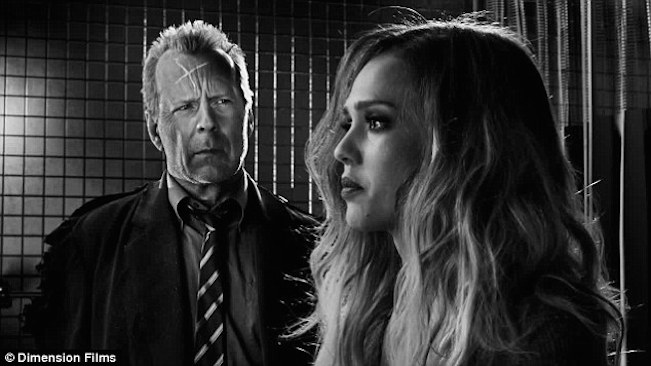 FRANK MILLER’S SIN CITY: A DAME TO KILL FOR (Two and a Half Stars)
FRANK MILLER’S SIN CITY: A DAME TO KILL FOR (Two and a Half Stars)




